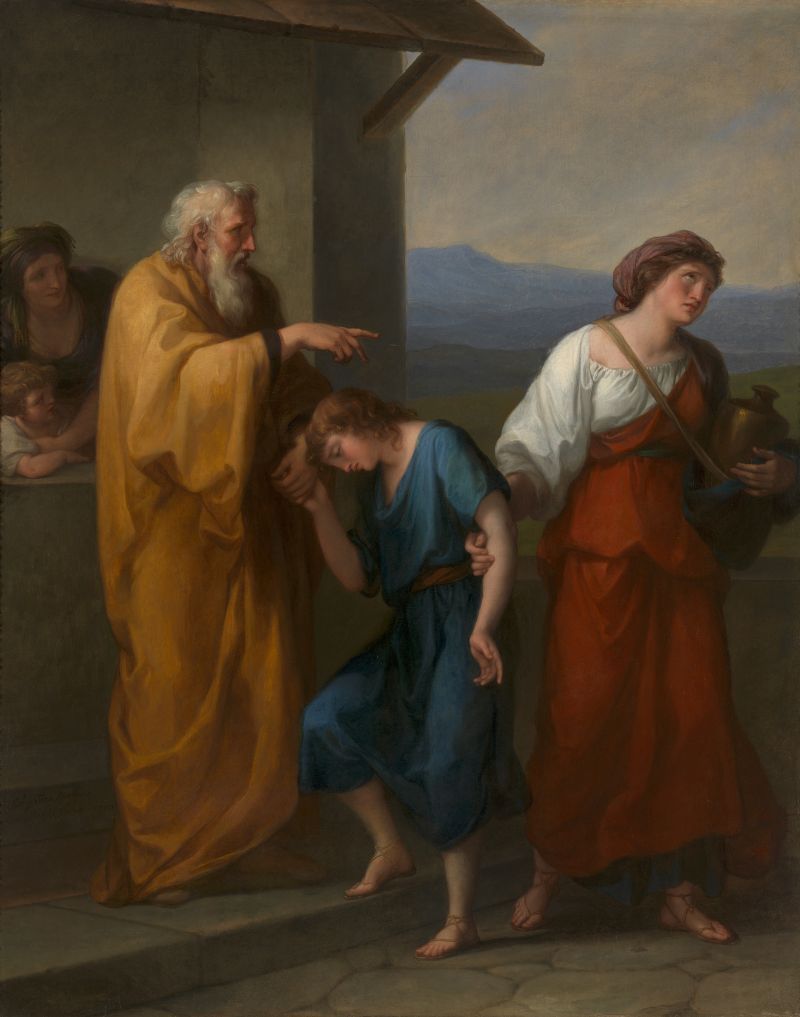It is intriguing to pose the question, who was the most famous living artist in 1792? In Britain, it was the year Joshua Reynolds died, and Thomas Lawrence was yet to make his international reputation; in France there was Jacques-Louis David, more concerned with politics than painting; in Italy Anton Raphael Mengs and Pompeo Batoni were both dead and Canova was only at the beginning of his career.
Arguably the most celebrated living painter was Angelica Kauffman. Kauffman’s patrons stretched from Warsaw to Philadelphia and she was in high demand as both a portraitist and history painter. By 1792 Kauffman had been living in Rome for a decade, having left Britain to focus on painting more ambitious, historical works, she occupied Mengs’s former studio on via Sistina and was at the heart of cultural life in the city. Kauffman’s international success eclipsed that of most of her male peers, by 1792 she was known throughout the Atlantic world, thanks to the many prints made after her works, by her first name alone. And yet she had forged a career in an environment where female creativity, though often singled out for praise, was systematically marginalised within institutions of art education and display.
By 1792 she was charging more than her male counterparts and, as her surviving account book proves, was in constant demand: her sitters include a who’s who of late eighteenth-century cultural figures from Winckelmann to Goethe. And yet, Kauffman is still regarded as a secondary figure in modern scholarship. Her gender is always foregrounded and the relative femininity of both her subject-matter and her strategies for navigating the contemporary art market are habitually stressed. As a result, the originality of Kauffman’s work as a painter is often overlooked: she was a pioneering neo-classical artist, who inflected her antique subjects with an unusual emotion; she was an iconographical pioneer, treating episodes from antiquity no previous artist had thought of and she was a technically brilliant painter, who produced images that hugely appealed to contemporaries and were reproduced on everything from furniture to fabric.
At London Art Week this Winter we will be showing one of Kauffman’s most striking late, historical works, Abraham Driving Out Hagar and Ishmael. The painting was commissioned in 1792 by the Turinese aristocrat Polissena Turinetti di Priero, it is therefore a rare example of Kauffman’s work commissioned by a female patron. Largely unknown in modern scholarship, the painting is a compelling essay in Kauffman’s mature neo-classical style and unusual in showing Kauffman tackling a Biblical subject. Preserved in exceptional condition, the painting offers valuable evidence for Kauffman’s sophisticated patronage within Europe.

Angelica Kauffman
Abraham driving out Hagar and Ishmael
Oil on canvas
50 ½ x 40 ½ inches; 1285 x 1030 mm
Signed and dated on the wall on the left: ‘Angelica Kauffman. Pinxit Roma. 1792’
In its original carved Roman frame
A Biblical subject gave Kauffman an unusual opportunity to explore certain formal conventions established by earlier painters. The costumes, style and approach to the composition recall Kauffman’s interest in a specific lineage of Roman painting from Raphael, through Guido Reni to Anton Raphael Mengs. As such the finished painting is an unusually ambitious historical work by Kauffman. Kauffman never outlined a theoretical position in print. However, the artist’s biographer de Rossi, described the artist as ‘la Pittrice delle Grazie’. In eighteenth-century terms, grace embodied the reason, erudition, judgment, and balance of her painting, aspects reinforced by her rational, learned, and virtuous personality. What makes Abraham driving Hagar and Ishmael into the Desert so remarkable is that it shows Kauffman reaching beyond her standard vocabulary of gracefulness to produce an image of Biblical grandeur.
We are delighted to be loaning this fabulous work to forthcoming exhibition devoted to Angelica Kauffman at Düsseldorf and the Royal Academy of Arts next year.
London Art Week Winter 2019 Opening Times:
Monday 2 December 10am to 6pm
Tuesday 3 December 10am to 6pm
Wednesday 4 December 10am to 6pm
Thursday 5 December 10am to 6pm
Friday 6 December 10am to 6pm
